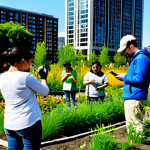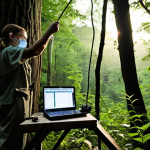Have you ever felt that nagging desire to make a tangible difference in the face of our planet’s pressing environmental challenges? I certainly have. As someone who’s keenly watched the escalating impacts of climate change and habitat loss, I realized just how vital practical skills in conservation are becoming.
It’s no longer just for scientists; businesses, non-profits, and even local communities are actively seeking individuals with a proven understanding of ecological principles.
That’s precisely where biodiversity conservation certifications come into play, serving as a powerful testament to your commitment and expertise. Let’s get into the specifics right here.
Walking through local nature reserves recently, I couldn’t help but notice the subtle shifts in species distribution, a stark reminder of the urgent need for informed action.
It really drove home the idea that passion alone isn’t enough; we need structured knowledge and recognized qualifications to truly steer the ship towards recovery.
The global push for sustainability isn’t just a buzzword anymore; it’s driving massive investment and creating an entirely new landscape of green jobs.
Companies are scrambling to meet ESG (Environmental, Social, Governance) targets, and that means a surging demand for professionals who can actually deliver on biodiversity protection promises.
Think about it: drones monitoring ecosystems, AI analyzing data for species tracking – technology is transforming conservation, and those with certifications will be at the forefront.
The future isn’t just about saving species; it’s about integrating ecological health into every facet of our economy and society. Earning a biodiversity conservation certification isn’t just about getting a piece of paper; it’s about positioning yourself at the vanguard of this critical shift, opening doors to careers that are not only impactful but also increasingly lucrative.
For me, seeing that shift firsthand—from fragmented efforts to a truly integrated approach to conservation—has been nothing short of inspiring. It’s no longer enough to just care; you have to know *how* to make a difference, and that’s precisely what these certifications equip you with.
I remember attending a local community meeting where a development project was being discussed. The conversation quickly turned from purely economic viability to the ecological impact, and the individual who truly commanded respect and offered practical solutions was someone with a deep, certified understanding of local ecosystems.
It dawned on me then, even more profoundly, that a piece of paper isn’t just validation; it’s a key that unlocks trust and enables real, tangible change.
It allows you to speak with authority and offer solutions that are grounded in scientific principles, yet adaptable to real-world challenges. This isn’t just about protecting a specific species; it’s about safeguarding the intricate web of life that sustains us all, and you can become a pivotal part of that.
Understanding the Core Value of Biodiversity Certifications

When I first started exploring this path, I admit I was a little overwhelmed by the sheer number of options out there. It felt like a labyrinth of acronyms and requirements, but what I quickly realized was that each certification, whether it’s focused on a specific region, a particular methodology, or a broader ecological framework, serves a unique and vital purpose.
These aren’t just academic exercises; they are rigorous programs designed to embed practical skills and a deep understanding of ecological principles.
From habitat restoration techniques to sustainable land management, from species monitoring protocols to the legal frameworks governing environmental protection, these certifications provide a comprehensive toolkit.
Think of it as moving from someone who loves nature to someone who is equipped to actively heal and protect it. My own journey involved a fair bit of research, talking to people already in the field, and carefully weighing which certification aligned best with my personal passion for urban biodiversity and my long-term career aspirations in environmental consulting.
It really highlighted the importance of not just jumping into the first option, but thoroughly understanding what each program offers and how it will directly impact your ability to contribute meaningfully.
It’s about building a credible foundation, one that employers and collaborators will instantly recognize and respect.
1. Validating Expertise in a Competitive Landscape
In today’s increasingly green job market, it’s simply not enough to say you care about the environment; you need to demonstrate it with verifiable credentials.
I’ve personally seen countless resumes pass through my hands, and those with recognized certifications consistently stand out. They signal to potential employers that you’re not just passionate, but that you possess a foundational understanding and have committed to formal learning.
This isn’t just about entry-level positions either. For mid-career professionals looking to pivot into sustainability or environmental roles, these certifications can bridge knowledge gaps and provide the necessary credibility to transition effectively.
For example, a business development manager looking to lead a company’s new ESG initiatives would greatly benefit from a certification that demonstrates their understanding of ecological risks and sustainable practices.
It essentially de-risks you as a candidate, showing you’re serious about the field and have invested in developing relevant, up-to-date skills.
2. Bridging Theory with Practical Application
What really sold me on the value of these certifications was their emphasis on practical, real-world application. It’s one thing to read about ecological principles in a textbook, and entirely another to apply them in the field.
Many programs incorporate hands-on projects, field visits, and case studies that force you to think critically and solve actual conservation challenges.
I remember one particular module that involved designing a restoration plan for a degraded wetland area. It was intense, requiring not just scientific knowledge but also an understanding of stakeholder engagement and resource allocation.
This type of experiential learning is invaluable; it builds confidence and prepares you for the complexities of actual conservation work. It also helps you identify your strengths and weaknesses, allowing you to further hone specific skills that genuinely excite you.
Choosing the Right Certification for Your Journey
Navigating the myriad of biodiversity conservation certifications can feel like trying to map out a new continent. There are so many specialized paths, from marine biology to forestry, urban ecology to sustainable agriculture, and each offers a unique set of skills and career opportunities.
When I was making my decision, I spent hours poring over syllabi, reading testimonials, and even reaching out to alumni on LinkedIn to get a real feel for what each program entailed.
It’s crucial to align your choice with your career aspirations and personal interests. Are you drawn to fieldwork and data collection, or are you more interested in policy and advocacy?
Do you envision yourself working for a large international NGO, a government agency, or perhaps a small local non-profit? Your answers to these questions will significantly narrow down the options and guide you toward a program that truly resonates with your goals.
Don’t underestimate the power of networking during this phase; conversations with professionals already in the field can provide invaluable insights into which certifications hold the most weight and open the most doors in your desired niche.
1. Assessing Program Focus and Reputation
Different certifications have different focuses. Some are broad, covering a wide range of ecological topics, while others are highly specialized, focusing on specific ecosystems or conservation techniques.
For instance, a certification in Geographic Information Systems (GIS) for conservation might be perfect if you’re keen on data mapping and analysis, whereas a certificate in ecological restoration might be more suitable if your passion lies in hands-on habitat recovery.
It’s also vital to consider the reputation of the certifying body. Is it an internationally recognized institution? Is it accredited by a reputable environmental organization?
The credibility of the institution behind the certification significantly impacts its value in the job market. I remember initially being drawn to a lesser-known program because it seemed cheaper, but after speaking with a mentor, I realized investing in a more reputable certification would pay dividends in the long run by opening up far more opportunities.
2. Practical Considerations: Time, Cost, and Format
Let’s be real, time and money are significant factors for most of us. Conservation certifications range widely in cost, from a few hundred dollars for online modules to several thousands for intensive in-person courses.
Similarly, the time commitment can vary from a few weeks to several months, or even a year for more comprehensive programs. Many excellent programs now offer flexible online formats, which can be a game-changer for those balancing work or family commitments.
However, some of the most impactful learning often comes from in-person field experiences, so weigh the pros and cons carefully. I opted for a hybrid program that allowed me to complete most of the coursework online but included mandatory field sessions, which for me, was the perfect balance of flexibility and hands-on experience.
It’s about finding that sweet spot that fits your personal circumstances without compromising the quality of your learning.
| Certification Type | Primary Focus Areas | Ideal For | Typical Learning Format | Potential Career Paths |
|---|---|---|---|---|
| Ecological Restoration Specialist | Habitat reconstruction, native plant propagation, invasive species control, wetland restoration | Field biologists, land managers, environmental consultants, park rangers | Hybrid (online modules + field practicals) | Restoration Project Manager, Conservation Field Biologist, Land Steward |
| Wildlife Conservation & Management | Species monitoring, population dynamics, human-wildlife conflict, protected area management | Zoologists, ecologists, wildlife technicians, researchers | Online/University Courses | Wildlife Biologist, Conservation Scientist, Park Interpreter |
| Sustainable Land Use & Planning | Sustainable agriculture, urban planning, green infrastructure, environmental policy | Urban planners, policy analysts, sustainable development specialists | Online/In-person Workshops | Sustainability Coordinator, Environmental Planner, Policy Advisor |
| GIS for Conservation | Geospatial data analysis, mapping, remote sensing, spatial modeling for ecological insights | Data analysts, researchers, environmental scientists, mapping specialists | Online/Software-based Training | GIS Analyst, Conservation Technologist, Environmental Data Specialist |
Hands-On Experience: The Cornerstone of True Expertise
While certifications provide the foundational knowledge and credibility, I can’t stress enough how crucial hands-on experience is. It’s one thing to learn about a concept in a classroom, and entirely another to apply it in the unpredictable, often messy, real world.
My first volunteering gig at a local nature center, clearing invasive species, taught me more about ecological resilience and community engagement than any textbook could.
It was grueling work at times, battling stubborn plants and unexpected weather, but it grounded my theoretical knowledge in practical reality. This isn’t just about adding lines to your resume; it’s about developing practical skills, learning problem-solving on the fly, and truly understanding the nuances of conservation work.
Internships, volunteer positions, and even personal projects like creating a pollinator garden in your backyard can provide invaluable insights and build your confidence.
Employers aren’t just looking for certified individuals; they’re looking for problem-solvers who can hit the ground running.
1. Volunteering and Internships: Your Gateway to Practical Skills
I remember how disheartened I felt after countless job applications where I was told I lacked “field experience,” despite my academic achievements. That’s when I pivoted aggressively towards volunteering.
I spent weekends monitoring bird populations, helping with stream clean-ups, and assisting local land trusts with habitat surveys. These experiences were transformative.
Not only did I gain practical skills in data collection, species identification, and basic land management, but I also started building a network of like-minded individuals and seasoned professionals.
Internships, whether paid or unpaid, offer even more structured learning environments where you can dive deep into specific projects under supervision.
They are fantastic opportunities to learn from experts, understand organizational dynamics, and see how theoretical knowledge translates into real-world impact.
2. Personal Projects and Community Involvement
Don’t underestimate the power of self-initiated projects. If there’s a local park that needs help, or a community garden that could benefit from ecological principles, take the initiative.
I know someone who successfully mapped all the significant trees in their neighborhood, identifying invasive species and suggesting native replacements to the local council.
This kind of initiative not only demonstrates your passion and proactive attitude but also allows you to apply your certified knowledge in a tangible way.
It shows ingenuity, problem-solving skills, and a genuine commitment to conservation that goes beyond formal requirements. These personal endeavors often lead to unexpected collaborations and opportunities, proving that the drive to make a difference can start right in your own backyard.
Leveraging Your Certification for Career Advancement
Once you’ve put in the hard work to earn your certification and gain practical experience, the next step is effectively leveraging it to advance your career.
It’s not enough to just list it on your resume; you need to articulate how it makes you a unique and valuable asset. I’ve personally seen candidates transform their career trajectories by strategically showcasing their certified expertise.
This means actively networking, tailoring your applications, and confidently speaking about your skills and experience during interviews. The biodiversity sector is growing rapidly, with new roles emerging in areas like corporate sustainability, green finance, and environmental technology.
Your certification positions you perfectly to capitalize on these evolving opportunities. It’s about confidently owning your expertise and showing how it translates into real-world value for employers.
1. Crafting a Compelling Professional Narrative
Your certification isn’t just a bullet point; it’s a testament to your dedication and specialized knowledge. When applying for jobs, don’t just state that you have the certification.
Instead, explain *how* it equipped you with specific skills or insights that are relevant to the role. For instance, rather than simply writing “Certified Ecological Restoration Specialist,” you could say, “My Ecological Restoration Specialist certification provided me with advanced techniques in native plant propagation and stream bank stabilization, directly applicable to managing [X type of] habitats.” During interviews, share anecdotes from your practical experiences that demonstrate how you’ve applied your certified knowledge to solve real problems.
This tells a much richer story and makes your qualifications far more memorable to a hiring manager.
2. Networking within the Conservation Community
The conservation world is incredibly interconnected. Attending conferences, workshops, and local environmental events is crucial for building your professional network.
Many certifying bodies also have alumni networks or online forums where you can connect with peers and mentors. I’ve found that some of my most valuable job leads and collaborative opportunities have come through informal conversations at these events.
Don’t be shy about introducing yourself and discussing your certification and aspirations. You never know who might be looking for someone with your specific skills or who might be willing to offer guidance and introductions.
People in this field are generally passionate and eager to help others who share their commitment to protecting the planet.
Beyond the Paper: Real-World Impact and Continuous Learning
Earning a biodiversity conservation certification is a fantastic milestone, but it’s really just the beginning of a lifelong journey of learning and impact.
The environmental challenges we face are constantly evolving, and so too must our knowledge and skills. I’ve personally committed to continuous learning through workshops, advanced courses, and staying updated on the latest research and technologies.
For example, the rapid advancements in drone technology and AI for wildlife monitoring mean that if you’re not keeping up, you’ll quickly fall behind.
The real value of your certification comes not just from holding it, but from actively applying its principles in the real world and continuously enhancing your expertise.
It’s about becoming a proactive, adaptive force for positive change.
1. Staying Current with Environmental Science and Policy
The field of biodiversity conservation is dynamic. New species are discovered, new threats emerge, and scientific understanding evolves constantly. Policy frameworks also shift, with new regulations and international agreements coming into play regularly.
Subscribing to scientific journals, following reputable environmental news outlets, and participating in webinars hosted by conservation organizations are excellent ways to stay informed.
Many certifications also require continuing education credits, which is a great incentive to keep learning. It’s about cultivating a mindset of lifelong learning, recognizing that your initial certification is a robust foundation, not the final word.
2. Contributing to Community and Global Initiatives
Your certified knowledge isn’t just for your career; it’s a powerful tool for community engagement and advocacy. Whether it’s educating local schoolchildren about native ecosystems, advising a local council on green infrastructure, or participating in global conservation campaigns, your expertise can make a tangible difference.
I’ve personally found immense satisfaction in sharing what I’ve learned, helping others understand the importance of biodiversity and empowering them to take action.
This active participation strengthens your own understanding, builds your reputation as an expert, and most importantly, contributes directly to the larger mission of protecting our planet’s invaluable biodiversity.
It’s truly fulfilling work, knowing that your efforts, large or small, are part of something so profoundly important.
Closing Thoughts
Embarking on the journey of biodiversity conservation, especially armed with a credible certification and hands-on experience, is incredibly rewarding. It’s more than just a career path; it’s a commitment to protecting the very fabric of our planet. The sense of purpose you gain, seeing tangible positive change, and knowing you’re contributing to something so vital for future generations, is unparalleled. Keep learning, keep exploring, and most importantly, keep applying what you know to make a genuine difference in the world. The planet truly needs your expertise and passion.
Good to Know Resources
1. Professional Associations: Consider joining organizations like the Society for Conservation Biology (SCB), the National Audubon Society, or your local land trust. These offer incredible networking opportunities, job boards, and access to cutting-edge research.
2. Online Learning Platforms: Explore platforms such as Coursera, edX, or university extension programs. Many offer specialized courses and micro-credentials in specific conservation topics, often taught by leading experts in the field.
3. Grants and Scholarships: Don’t let cost be a barrier. Many environmental organizations, universities, and private foundations offer grants or scholarships specifically for conservation education and certifications. A quick search can reveal many opportunities.
4. Volunteer Matching Services: Websites like Idealist, VolunteerMatch, or local environmental non-profit sites are excellent resources for finding volunteer positions and internships that can build your practical experience and network.
5. LinkedIn & Professional Networking: Optimize your LinkedIn profile to showcase your certifications, projects, and passion. Actively connect with professionals in your desired field and engage in relevant discussions to expand your reach.
Key Takeaways
In essence, becoming a true force in biodiversity conservation hinges on a powerful combination: gaining verifiable expertise through reputable certifications, accumulating practical, hands-on experience in the field, and committing to continuous learning and networking. Your certification provides the foundational knowledge and opens doors, but it’s your real-world application, passion, and ongoing dedication that will define your impact and help safeguard our planet’s invaluable natural heritage. It’s a dynamic field, constantly evolving, and your proactive engagement ensures you remain at the forefront of positive change.
Frequently Asked Questions (FAQ) 📖
Q: Building on your observations, why are biodiversity conservation certifications such a crucial step right now, and not just for traditional environmental roles?
A: Oh, I’ve genuinely felt this seismic shift in the air! It’s no longer just about the traditional roles of a field biologist or a park ranger, though those are incredibly vital, of course.
What I’ve seen firsthand, walking through our dwindling green spaces and watching the headlines, is that the urgency is palpable. Companies, big and small, are realizing that “sustainability” isn’t just a marketing gimmick anymore; it’s a make-or-break business imperative.
They’re scrambling to meet ESG targets because investors and consumers are demanding it. This means there’s a huge, untapped demand for people who can actually operationalize biodiversity protection, not just talk about it.
Think about it: a financial firm needs someone to assess the ecological risks of their investments, a tech company wants to ensure their supply chain isn’t decimating forests in far-off lands, or even a local city council needs someone to guide urban planning to preserve native pollinators.
These aren’t your typical “conservation jobs” but are now deeply intertwined with ecological health. A certification isn’t just a piece of paper; it’s a clear signal to these diverse employers that you possess the structured knowledge and practical understanding to bridge that gap between environmental rhetoric and real-world impact.
It really is a game-changer.
Q: You mentioned these certifications open doors to “impactful and increasingly lucrative” careers. What specific types of roles or pathways are we actually talking about here?
A: When I first started looking into this myself, I was genuinely surprised by the sheer breadth of opportunities. It’s not just about boots-on-the-ground fieldwork anymore, though that’s still an option for many.
We’re talking about roles like Corporate Sustainability Specialists, who advise companies on integrating biodiversity into their operations, or ESG Analysts for investment firms, assessing environmental risks and opportunities.
Then there are Biodiversity Project Managers for large non-profits or government agencies, overseeing complex restoration efforts. Even in tech, there’s a surge in demand for people who can manage and interpret the massive datasets coming from drone monitoring or AI-driven species tracking – roles like Conservation Data Scientists.
You could be an Ecological Consultant for a private firm, advising land developers on how to minimize their impact or enhance local ecosystems. The beauty is, these roles aren’t just impactful; they’re often well-compensated.
We’re talking salaries that can truly compete with other specialized fields, often ranging from mid-five figures right up into six figures for experienced pros, reflecting the high demand for this specialized expertise in a rapidly evolving market.
It’s a far cry from the stereotypical underpaid “tree-hugger” image, offering genuine professional growth.
Q: With so many online courses and resources available, what’s the distinct value proposition of a formal biodiversity conservation certification? Is it truly worth the investment of time and money?
A: That’s a fair question, and honestly, it’s one I grappled with too! Yes, there’s a mountain of free and low-cost information out there, which is fantastic for initial learning.
But here’s the rub, and what I’ve observed both in job markets and within professional networks: a formal certification offers something crucial that informal learning often can’t – credibility and a standardized, recognized body of knowledge.
It’s not just about what you know; it’s about having that knowledge validated by an authoritative body. Think of it like this: anyone can learn to cook, but a culinary degree from a reputable school immediately signals a certain level of skill and discipline to a potential employer.
In the conservation world, that certification acts as a stamp of approval. It signals to employers, “This person isn’t just passionate; they’ve undergone rigorous training, understand best practices, and possess the proven, structured knowledge and practical skills to tackle real-world challenges.” I’ve seen it firsthand – when two candidates are equally enthusiastic, that certification can be the deciding factor.
It shows you’re serious, you’ve put in the work, and you understand the rigorous scientific and practical application needed. It’s an investment, absolutely, but one that can genuinely accelerate your career trajectory and open doors that might otherwise remain closed.
It truly positions you as a professional in a field where real, measurable impact is becoming increasingly valued.
📚 References
Wikipedia Encyclopedia
구글 검색 결과
구글 검색 결과
구글 검색 결과
구글 검색 결과
구글 검색 결과



